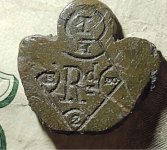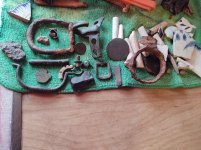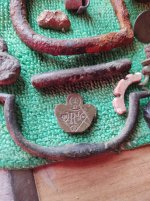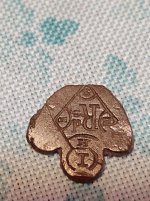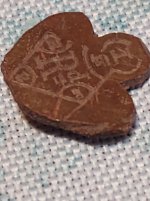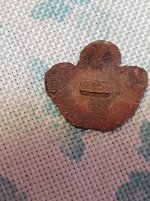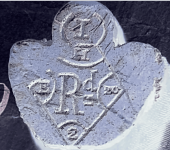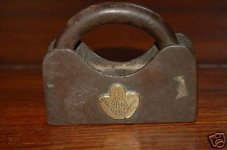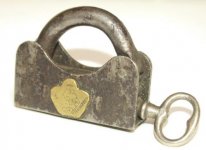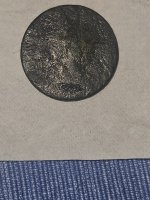You are using an out of date browser. It may not display this or other websites correctly.
You should upgrade or use an alternative browser.
You should upgrade or use an alternative browser.
Apothecary Weight or What???
- Thread starter Bharpring
- Start date
DCMatt
Gold Member
- Oct 12, 2006
- 10,356
- 13,478
- Detector(s) used
- Minelab Equinox 600, EX II, & Musketeer, White's Classic
- Primary Interest:
- Metal Detecting
I'm guessing 'coin weight' not apothecary. Interesting that it is 'crown shaped'. Never seen one like that... Can you tell exactly what the letters are? Maybe make a sketch?
Most British coin weights have S for shilling and P for Pence. So it might have a crown and S 2 P 6 for 2 shillings 6 Pence. I can't make any sense of yours. Maybe one of the Brits will chime in with more info.
Most British coin weights have S for shilling and P for Pence. So it might have a crown and S 2 P 6 for 2 shillings 6 Pence. I can't make any sense of yours. Maybe one of the Brits will chime in with more info.
Upvote
0
Vermont treasure hunter
Hero Member
- Jul 7, 2020
- 504
- 774
- Detector(s) used
- An old radio shack, simplex
- Primary Interest:
- All Treasure Hunting
That is a very cool find! Have no idea but definitely some sort of lead weight. 

Upvote
0
Red-Coat
Gold Member
It’s possible that this might be a weight, but those markings have nothing whatsoever to do with weights.
What you have is a British Patent Mark (also known as a Lozenge mark and sometimes incorrectly as a ‘kite’ mark) to indicate that the item carrying the mark is protected by a design registration. It’s of the style in use between 1842-1867. The mark can be read as follows:
At the top is the roman numeral ‘I’ which represents the class of goods for the registration. Class I is for items made from metal (Class II is for wood, Class III for glass and so on up to XIII for textiles).
Directly below, the letter ‘H’ is a year letter, in this case it denotes 1843.
At the centre, you have ‘Rd’, which is just an abbreviation for “Registered”.
Either side of the ‘Rd’ you have the letter ‘B’ and the number ‘20’. These denote the month and day of the registration. The ‘B’ is for October, so the design was registered on 20th October 1843.
At the very bottom, you have the number ‘2’ and this is the ‘bundle number’ (also known as a ‘package number’) which indicates how many different items are covered by a single design registration. So, this is one of two items made to the same design.
I’m a bit doubtful that it’s a weight (or at least that it was originally produced as such). If it were, why were there two items made to the same design? If it were part of a set of weights made to the same design, surely there would be more than two of them?
It’s possible that this was scavenged from some unknown metal item and cut to that size/shape for use as a weight, but my guess is that it's just a broken piece from something larger... perhaps the foot from some kind of container or vessel(?) When I have a bit more time I’ll do a search on British Patents for that date to try and identify what it was originally.
What you have is a British Patent Mark (also known as a Lozenge mark and sometimes incorrectly as a ‘kite’ mark) to indicate that the item carrying the mark is protected by a design registration. It’s of the style in use between 1842-1867. The mark can be read as follows:
At the top is the roman numeral ‘I’ which represents the class of goods for the registration. Class I is for items made from metal (Class II is for wood, Class III for glass and so on up to XIII for textiles).
Directly below, the letter ‘H’ is a year letter, in this case it denotes 1843.
At the centre, you have ‘Rd’, which is just an abbreviation for “Registered”.
Either side of the ‘Rd’ you have the letter ‘B’ and the number ‘20’. These denote the month and day of the registration. The ‘B’ is for October, so the design was registered on 20th October 1843.
At the very bottom, you have the number ‘2’ and this is the ‘bundle number’ (also known as a ‘package number’) which indicates how many different items are covered by a single design registration. So, this is one of two items made to the same design.
I’m a bit doubtful that it’s a weight (or at least that it was originally produced as such). If it were, why were there two items made to the same design? If it were part of a set of weights made to the same design, surely there would be more than two of them?
It’s possible that this was scavenged from some unknown metal item and cut to that size/shape for use as a weight, but my guess is that it's just a broken piece from something larger... perhaps the foot from some kind of container or vessel(?) When I have a bit more time I’ll do a search on British Patents for that date to try and identify what it was originally.
Last edited:
Upvote
0
- Oct 26, 2004
- 24,138
- 22,963
- 🏆 Honorable Mentions:
- 2
- Detector(s) used
- Minelab Explorer
- Primary Interest:
- Shipwrecks
Outstanding ID, Red Coat
Here's a source for similar ID's:
LOZENGE MARK - PATENT MARK (BRITISH)
Don.....
Here's a source for similar ID's:
LOZENGE MARK - PATENT MARK (BRITISH)
Don.....
Upvote
0
Red-Coat
Gold Member
Outstanding ID, Red Coat
Here's a source for similar ID's:
LOZENGE MARK - PATENT MARK (BRITISH)
Don.....
Thanks Don. Just to clarify, although the site you linked to is in reference to these marks on silver plate, that doesn't mean the item in question here was ever silver plated. Class I registrations are for metal items in general, whatever the metal.
Upvote
0
Matt~Klein
Greenie
- Jan 25, 2021
- 12
- 25
- Detector(s) used
- Xp Deus ORX / Tesoro Bandito II
- Primary Interest:
- All Treasure Hunting
Upvote
0
Matt~Klein
Greenie
- Jan 25, 2021
- 12
- 25
- Detector(s) used
- Xp Deus ORX / Tesoro Bandito II
- Primary Interest:
- All Treasure Hunting
Upvote
0
Red-Coat
Gold Member
Bingo! I always have trouble reading letters stamped on metal in photographs.
It is indeed an ‘E’, giving the patent registration date of 20 May 1843. The patent was filed by Abraham Thompson of Little London, Willenhall for a ‘screw’ padlock. Little London is a large village near Willenhall in Staffordshire, England.
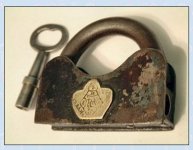
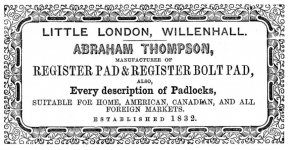
It is indeed an ‘E’, giving the patent registration date of 20 May 1843. The patent was filed by Abraham Thompson of Little London, Willenhall for a ‘screw’ padlock. Little London is a large village near Willenhall in Staffordshire, England.


Upvote
0
CRUSADER
Gold Member
Exactly what I was going to say. Part of a padlock.Thanks yall for the Info I am the digger. Another site offered this View attachment 1897252
Upvote
0
Users who are viewing this thread
Total: 2 (members: 0, guests: 2)
